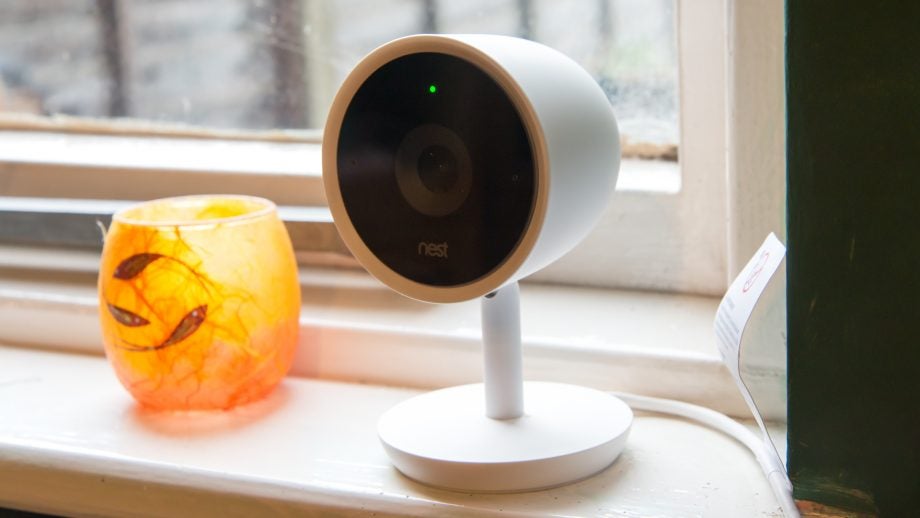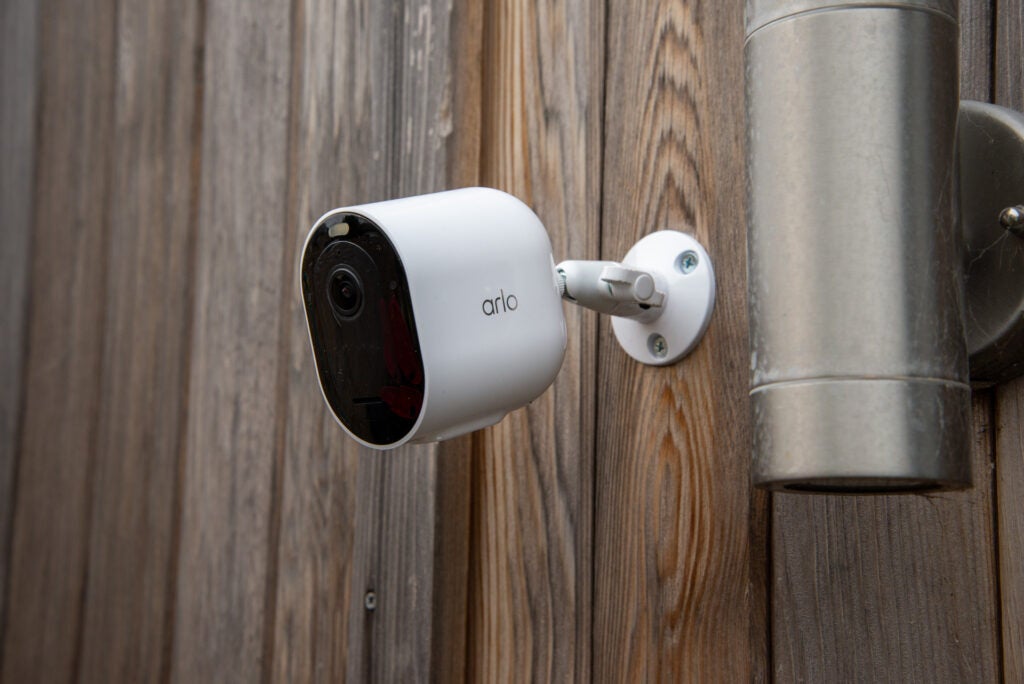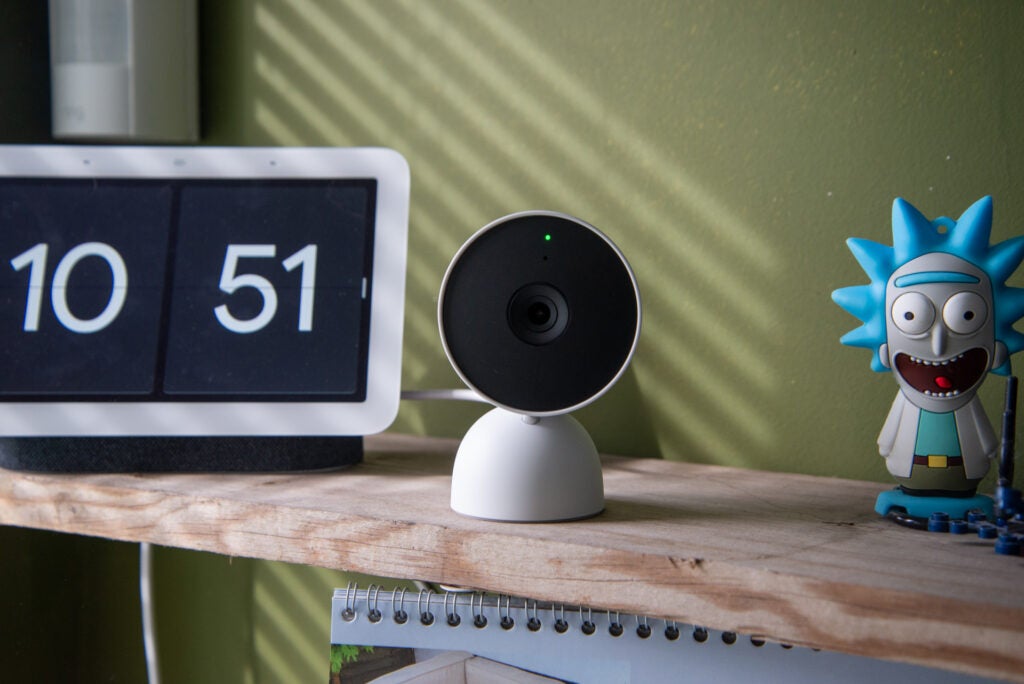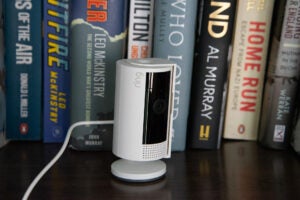Best Indoor Security Camera 2024

An indoor security camera is one of the best ways to protect your home when you’re away. If anything happens, then you can easily see what’s going on immediately, giving you a chance to call the police. There are lots of options out there, but our guide to the best security cameras will help you find the right one.
We’ve tested hundreds of security cameras before but here is our list of the best ones only. Each entry has a full description of the camera, but you can also click the links to jump to the full review.
Before you start looking for your cameras, it’s worth saying that you should buy multiple cameras from the same manufacturer to keep the cost of cloud storage down.
Best indoor security cameras at a glance
- Best overall: Arlo Pro 5 – check price
- Best budget indoor camera: Ring Indoor Camera (2nd Gen) – check price
- Best value cloud indoor security camera: Nest Cam (indoor, wired) – check price
- Best Apple HomeKit camera: Eve Cam – check price
How We Test
All of our indoor security cameras are installed inside our test lab, monitoring real people. We run them for at least a week, so that we can tweak motion detection and find out how reliable or annoying each model is. We download sample footage from each camera, too, so that we can compare image quality between devices.
- Excellent night footage
- Improved battery life
- Powerful smart detection features
- New app removes some features
- Can’t move widgets around
- Built-in recording
- Integrated object detection
- Good video quality
- New app worse than old one
- Works with Google Assistant only
- Works with HomeKit
- Flexible installation options
- Decent daylight image quality
- No Android, Alexa or Google assistant support
- Comparatively expensive
- Excellent value
- Fully integrates with Ring
- Privacy slider
- So-so video quality

Arlo Pro 5
The best overall indoor security camera
Pros
- Excellent night footage
- Improved battery life
- Powerful smart detection features
Cons
- New app removes some features
- Can’t move widgets around
Arlo has consistently produced the best cameras and the best app, and the Arlo Pro 5 is no different. This model is the upgraded version of the Pro 4 and requires the new Arlo app to work. Largely successful, the new app simplifies the interface, using three simple armed modes (home, away, and standby), which can be used to choose which cameras are active when. Modes can be changed manually or automatically on a schedule or location.
Although the Pro 5 has the same 2K resolution as the Pro 4, Arlo has updated the sensor to a 12-bit version, up from the 10-bit sensor on the old one. This improves colour capture (up to 68bn colours), which also means that colour night vision looks better.
Combined with the spotlight, there’s no need for IR lights (although the camera does have them), as the Pro 5 can capture nighttime shots in glorious colour. During the day, this camera shoots brilliant video, that’s sharper and more detailed than the Pro 4’s.
As with other Arlo cameras, the Pro 5 is battery powered. It can be charged in-situ via an optional solar panel or brought inside and charged regularly. Arlo has improved battery life here, promising 30% more life compared to the Pro 4. That is about right in our tests.
We think that this is the best overall security camera and system, but I have to say that the hardware is expensive and the cloud subscription, which is required to capture video, is more expensive than that of the competition. If you want the best, then the money is worth it, but if you’re on a tight budget, look elsewhere.
Reviewer: David Ludlow
Full review: Arlo Pro 5 review

Ring Indoor Camera (2nd Gen)
The best budget indoor camera
Pros
- Excellent value
- Fully integrates with Ring
- Privacy slider
Cons
- So-so video quality
The Ring Indoor Camera (2nd Gen) is the best cheap indoor camera we’ve tested here at Trusted Reviews. The second-generation Ring Indoor camera offers excellent value for money and works brilliantly alongside other Ring devices – though having a large Ring setup isn’t a requirement to use the security camera.
Physically, the Ring Indoor Camera (2nd Gen) is a refinement of the first-generation Indoor Camera. The Indoor Camera can be positioned on a shelf using the flexible stand or mounted on a wall more permanently.
The biggest physical difference between the two cameras is the security shutter that blocks the lens when the camera isn’t recording. This should give you some peace of mind if you’re concerned about being spied on when the camera is switched off.
As far as software goes, the Indoor Camera (2nd Gen) works best when used alongside Amazon’s Ring Protect Plan, a subscription service that gives you access to additional features such as Ring Alarm for a monthly price.
The Indoor Camera includes a PIR sensor with motion detection that sends alerts to the app when activated. This can be finetuned with motion activity zones that let you specify exactly which areas you want to monitor, as well as Smart Alerts that only trigger a notification when the camera spots a person.
Recorded events are stored in the cloud and accessible via the app with filters for events and dates that make it easy to find specific pieces of footage.
When it comes to the actual footage capture, the Ring Indoor Camera has a 143-degree field of view that allows it to capture most of a room without trouble. However, you’ll want to be conscious of where you place the camera as we found that pointing it toward a south-facing door overexposed the video and made it tricky to make out details.
The 1080p camera doesn’t produce the highest resolution video around either, but it does do a solid job of making it clear what’s going on in your home. There are full-colour night vision and IR views that make it possible to monitor your home overnight, along with a two-way talk feature with a clear microphone and loudspeaker that can be used to tell intruders to get lost.
Reviewer: David Ludlow
Full Review: Ring Indoor Camera (2nd Gen)

Nest Cam (indoor, wired)
The best value cloud indoor security camera
Pros
- Built-in recording
- Integrated object detection
- Good video quality
Cons
- New app worse than old one
- Works with Google Assistant only
While the majority of the revamped Nest range of cameras was quite expensive, the Nest Cam (indoor, wired) is a more wallet-friendly option. Despite the lower price, this camera has a lot of features that make it stablemates so good.
Top of the list is built-in recording, which lets this camera capture up to three hours of video without requiring a cloud subscription. If you do take out a Nest Aware subscription, which is good value and covers all cameras in your home, the camera’s onboard storage can be used in the event of an internet outage. When the internet comes back, the saved footage is uploaded to the cloud, so you should never miss a beat.
On-board, this camera has object detection, letting it tell the difference between people, animals and vehicles; you can then choose what you want to be told about, reducing the number of alerts that you get.
Control is via the Google Home app, rather than the superior Nest app. It’s a little clunky to use but you should still easily be able to find the footage that you want. The only thing really missing is more control over how and when the camera records.
Reviewer: David Ludlow
Full review: Nest Cam (indoor, wired) review

Eve Cam
The best Apple HomeKit camera
Pros
- Works with HomeKit
- Flexible installation options
- Decent daylight image quality
Cons
- No Android, Alexa or Google assistant support
- Comparatively expensive
If you’re an iPhone user and have been hunting for a camera that integrates well with HomeKit, the Eve Cam could be ideal. It’s a little expensive for a basic 1080p camera, but for those that live in an Apple world, it could be a great addition to your home’s security.
With its round head mounted to a flexible stand, this camera looks basic but functional. It’s surprisingly flexible, and can be desk-mounted, rotating 360 degrees with 180 degrees of angle adjustment, or wall-mounted.
You install the camera using either the Eve app or the Home app, both of which add the camera to HomeKit. You can view the camera’s live feed through both apps, but the Home app is better. There’s no cloud connection involved, and you connect directly to the camera. However, you do need to have a Home Hub on your network, such as a HomePod Mini for remote connections.
You can stream what’s currently happening and turn on two-way talk to have a conversation with anyone that you can see. For more advanced options you need to have an iCloud+ plan to enable HomeKit Secure Video. As this is a HomeKit only camera, there’s no Alexa or Google Assistant support, nor IFTTT support.
As well as recording any motion, you can instead select to only record when people, animals, vehicles or packages are detected. You can also set up activity zones, so only motion in those areas of interest are recorded.
The Eve Cam has a 1080p sensor and a 150-degree field of view, which is pretty good for an indoor camera: that’s enough to capture most of a room, particularly if you can place the camera in a corner.
Video quality depends on the lighting available. During the day, when there’s a good amount of light, the video quality is pretty good. At night, the camera switches to its IR view, using its built-in LEDs to shoot in black and white. This removes quite a bit of detail from the picture, including from people.
Reviewer: David Ludlow
Full review: Eve Cam review
FAQs
Inside, there are fewer problems getting to a power socket, so mains-powered cameras make a lot of sense and you don’t have to worry about changing batteries.
That said, if you want to put cameras in some areas that are usually poorly covered by power sockets, such as hallways, then a battery powered model makes sense. Just be careful where you place a model like this, as pets walking around can drain the battery.
There’s little point in buying anything other than a 1080p model at the moment, as you’ll get sharp-enough footage to capture everything you need. Go for 2K or 4K footage if you want even more detailed footage.
You should turn indoor cameras off when you’re at home and off when you’re out or its night time, as this means that you won’t record yourself by accident when you’re walking around.
The best cameras have tools to make this easier, such as Ring cameras, which let you activate or deactivate cameras based on the Ring Alarm setting.
The advantage of cloud storage is that any footage is safe from theft; you can always download it and hand it over to the police. However, there’s a monthly cost associated with this. If you only want the odd bit of footage and don’t want to be tied to monthly plans, look for a camera that has local storage instead.
Cameras that you can remote control to pan and tilt around used to be very popular, giving you a way to look around to see what’s going on.
They’ve fallen out of favour for two reasons.
First, they’re expensive.
Secondly, if you move the camera’s field of view, you may not be covering the most important parts of your property.
And, motion zones don’t work with these cameras, as you can’t mark an area to watch if you may move the camera. Instead, we recommend buying a fixed camera and focussing in on the area that you want to monitor. If you need more coverage add an additional camera.
Amazon Alexa and Google Assistant support is handy if you want to stream footage to your TV or screen-enabled smart speaker.
IFTTT can be useful, too, letting you control other devices when motion is detected, such as turning on a light automatically.
Nest cameras have Works With Nest automatic rules, so they can be turned on automatically when a smoke alarm goes off, for instance, or they can turn on your Hue lights automatically if suspicious activity is detected.









